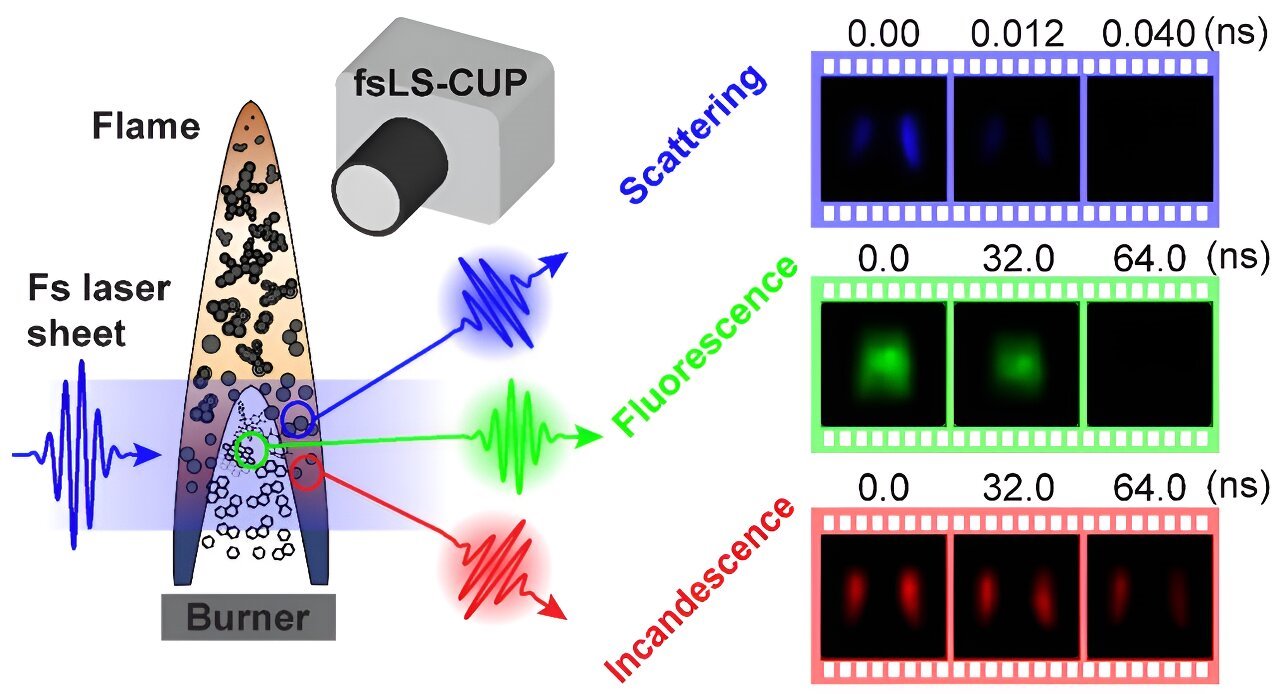
The fsLS-CUP system rapidly captures image sequences of soot scattering, PAH fluorescence, and incandescence in flames. (Image Credit: Yogeshwar Nath Mishra, Peng Wang, Florian J. Bauer, Murthy S. Gudipati, and Lihong V. Wang)
Researchers from the California Institute of Technology and Friedrich-Alexander University Erlangen have developed a new 2D imaging technique: femtosecond laser sheet-compressed ultrafast photography (fsLS-CUP). It's the world's fastest single-shot planar imaging system that captures events of femtosecond laser-flame dynamics at 250 billion frames per second (Gfps)---20,000 times faster than modern imaging systems.
The fsLS-CUP uses an ultra-short laser pulse to capture three wide-field, real-time types of data simultaneously. It reveals laser-induced heating (LIH) from soot particles, captures elastic light scattering (ELS) when the laser interacts with soot, and shows laser-induced fluorescence from PAHs.
"Scientists have used ultrafast laser pulses to capture rapid chemical reactions and laser interactions with materials in real-time. Using a femtosecond laser and a streak camera, we have developed a new 2D imaging method, fsLS-CUP, that can capture some extremely fast phenomena in nature," said Dr. Yogeshwar Nath Mishra
"Ultimately, it has not only advanced our understanding of hydrocarbon and nanoparticle formation and growth in flames but also holds potential across multiple fields, making it a significant milestone in ultrafast imaging technology. Our research, which includes the fastest observation of PAHs, complements NASA's mission to explore the origins of life and cosmic evolution. Beyond combustion research, this technique has broad applications in physics, chemistry, biology, medicine, energy, and environmental science."
The team believes their advancement represents a big step toward ultrafast imaging that has the potential to unlock rapid phenomena in science and technology. They're also focusing on improving imaging performance, including spatial resolution, speed, and image reconstruction fidelity.
So far, the team used this imaging technique to observe laser interaction with soot and PAHs during burning processes. The collaboration between both institutes could expand scientists' understanding and unlock more discoveries in this field. This fsLS-CUP technique paves the way toward investigating transient phenomena in a planar setting.
The fsLS-CUP leverages compressed sensing to capture data in a single femtosecond laser pulse. It provides a wide field of view, resolving spatial and temporal details. It can also observe varying femtosecond laser-induced signals in PAHs and carbon nanoparticles.
"PAHs are robust molecules in interstellar space. Understanding the formation of PAHs and carbon soot expands our knowledge about their existence under astrophysical conditions as well," said Dr. Murthy S. Gudipati, an expert in PAH astrochemistry. "Our study is relevant to PAH formation in hot environments, such as carbon-rich asymptotic giant branch stars. These evolved stars have hot atmospheres and strong stellar winds, creating ideal conditions for PAH formation. Additionally, the hot, expanding ejecta of supernova explosions provide another environment where PAHs could potentially form at high temperatures."
Have a story tip? Message me at: http://twitter.com/Cabe_Atwell

-

aswinvenu
-
Cancel
-
Vote Up
0
Vote Down
-
-
Sign in to reply
-
More
-
Cancel
Comment-

aswinvenu
-
Cancel
-
Vote Up
0
Vote Down
-
-
Sign in to reply
-
More
-
Cancel
Children